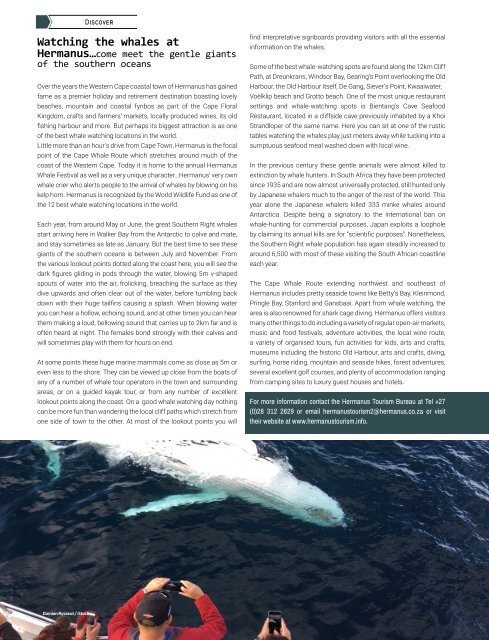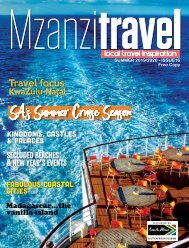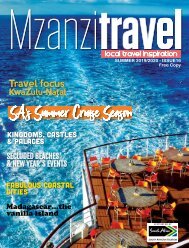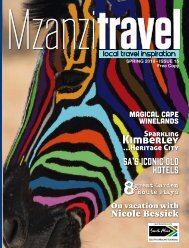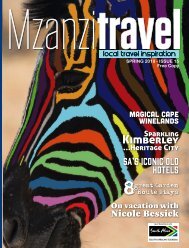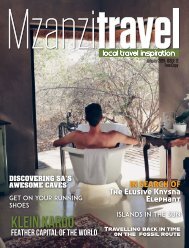Create successful ePaper yourself
Turn your PDF publications into a flip-book with our unique Google optimized e-Paper software.
Discover<br />
Watching the whales at<br />
Hermanus…come meet the gentle giants<br />
of the southern oceans<br />
Over the years the Western Cape coastal town of Hermanus has gained<br />
fame as a premier holiday and retirement destination boasting lovely<br />
beaches, mountain and coastal fynbos as part of the Cape Floral<br />
Kingdom, crafts and farmers’ markets, locally produced wines, its old<br />
fishing harbour and more. But perhaps its biggest attraction is as one<br />
of the best whale watching locations in the world.<br />
Little more than an hour’s drive from Cape Town, Hermanus is the focal<br />
point of the Cape Whale Route which stretches around much of the<br />
coast of the Western Cape. Today it is home to the annual Hermanus<br />
Whale Festival as well as a very unique character…Hermanus’ very own<br />
whale crier who alerts people to the arrival of whales by blowing on his<br />
kelp horn. Hermanus is recognized by the World Wildlife Fund as one of<br />
the 12 best whale watching locations in the world.<br />
Each year, from around May or June, the great Southern Right whales<br />
start arriving here in Walker Bay from the Antarctic to calve and mate,<br />
and stay sometimes as late as January. But the best time to see these<br />
giants of the southern oceans is between July and November. From<br />
the various lookout points dotted along the coast here, you will see the<br />
dark figures gliding in pods through the water, blowing 5m v-shaped<br />
spouts of water into the air, frolicking, breaching the surface as they<br />
dive upwards and often clear out of the water, before tumbling back<br />
down with their huge tailfins causing a splash. When blowing water<br />
you can hear a hollow, echoing sound, and at other times you can hear<br />
them making a loud, bellowing sound that carries up to 2km far and is<br />
often heard at night. The females bond strongly with their calves and<br />
will sometimes play with them for hours on end.<br />
At some points these huge marine mammals come as close as 5m or<br />
even less to the shore. They can be viewed up close from the boats of<br />
any of a number of whale tour operators in the town and surrounding<br />
areas, or on a guided kayak tour, or from any number of excellent<br />
lookout points along the coast. On a good whale watching day nothing<br />
can be more fun than wandering the local cliff paths which stretch from<br />
one side of town to the other. At most of the lookout points you will<br />
find interpretative signboards providing visitors with all the essential<br />
information on the whales.<br />
Some of the best whale-watching spots are found along the 12km Cliff<br />
Path, at Dreunkrans, Windsor Bay, Gearing’s Point overlooking the Old<br />
Harbour, the Old Harbour itself, De Gang, Siever’s Point, Kwaaiwater,<br />
Voëlklip beach and Grotto beach. One of the most unique restaurant<br />
settings and whale-watching spots is Bientang’s Cave Seafood<br />
Restaurant, located in a cliffside cave previously inhabited by a Khoi<br />
Strandloper of the same name. Here you can sit at one of the rustic<br />
tables watching the whales play just meters away while tucking into a<br />
sumptuous seafood meal washed down with local wine.<br />
In the previous century these gentle animals were almost killed to<br />
extinction by whale hunters. In South Africa they have been protected<br />
since 1935 and are now almost universally protected, still hunted only<br />
by Japanese whalers much to the anger of the rest of the world. This<br />
year alone the Japanese whalers killed 333 minke whales around<br />
Antarctica. Despite being a signatory to the international ban on<br />
whale-hunting for commercial purposes, Japan exploits a loophole<br />
by claiming its annual kills are for “scientific purposes”. Nonetheless,<br />
the Southern Right whale population has again steadily increased to<br />
around 6,500 with most of these visiting the South African coastline<br />
each year.<br />
The Cape Whale Route extending northwest and southeast of<br />
Hermanus includes pretty seaside towns like Betty’s Bay, Kleinmond,<br />
Pringle Bay, Stanford and Gansbaai. Apart from whale watching, the<br />
area is also renowned for shark cage diving. Hermanus offers visitors<br />
many other things to do including a variety of regular open-air markets,<br />
music and food festivals, adventure activities, the local wine route,<br />
a variety of organised tours, fun activities for kids, arts and crafts,<br />
museums including the historic Old Harbour, arts and crafts, diving,<br />
surfing, horse riding, mountain and seaside hikes, forest adventures,<br />
several excellent golf courses, and plenty of accommodation ranging<br />
from camping sites to luxury guest houses and hotels.<br />
For more information contact the Hermanus Tourism Bureau at Tel +27<br />
(0)28 312 2629 or email hermanustourism2@hermanus.co.za or visit<br />
their website at www.hermanustourism.info.<br />
Damian Ryszawi / iStock


